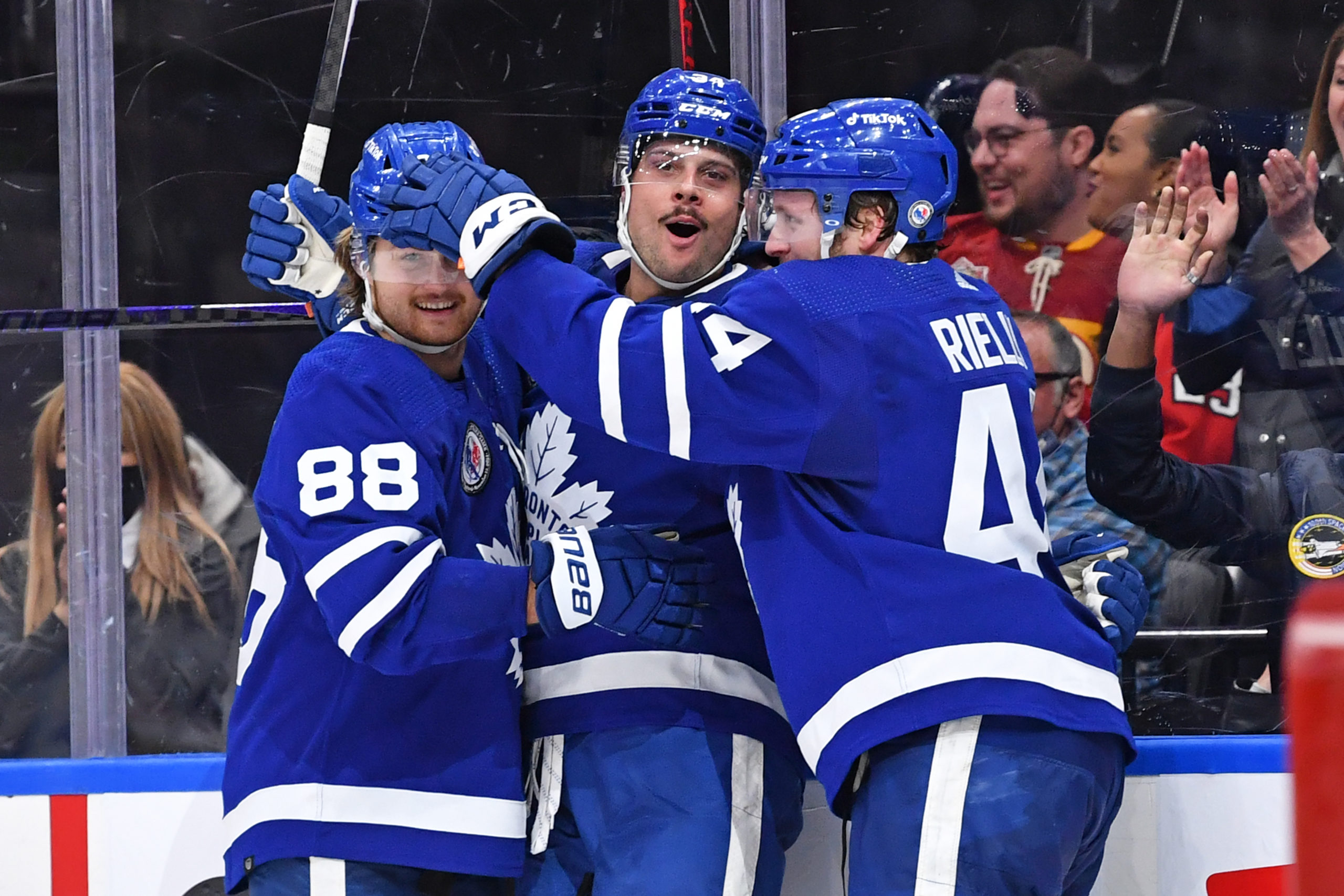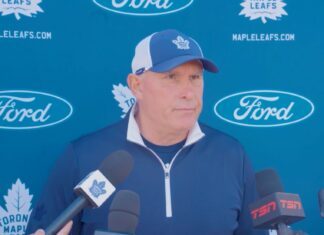Three weeks after we flipped the NHL calendar to a new year, the Maple Leafs’ lineup looks different. It’s deeper, but is it better?
After I wrote out some offseason thoughts last week, the Leafs continued remaking their forward group by acquiring Dakota Joshua, who joins Matias Maccelli and Nicolas Roy as a trio of new forwards we can pen into next season’s lineup.
We already know Mitch Marner (81 games), Pontus Holmberg (68 games), and Ryan Reaves (35 games) are gone, and there’s likely more departures to come. Max Pacioretty remains unsigned (37 games), and it’s easy to forget that Connor Dewar played 31 games last season (three assists), too.
There’s change every summer — for every team — and this isn’t exactly an above-average amount of personnel change so far. Still, there is a lot to sort through, given Marner’s prominence on the team and how his departure fundamentally alters the roster and the deployment.
It leaves a lot to analyze, discuss, and piece together. Let’s break it down into segments: bottom six, top six, and internal improvement.
The bottom six is clearly deeper
Over the past two seasons, these are the bottom six units the Leafs rolled out in Game 1 of 82:
2024-25
Pacioretty-Holmberg-Robertson
Lorentz-Kampf-Reaves
2023-24
Knies – Minten – Jarnkrok
Gregor – Kampf – Reaves
Moving Ryan Reaves alone is a significant upgrade as long as he’s not replaced by Michael Pezzetta, who Reaves actually outscored last season. The Leafs could very well run what was effectively their third line last spring, Lorentz-Laughton-Jarnkrok, as their fourth line.
While I don’t want to spend a ton of time on line combinations at this juncture of the NHL calendar, I’d actually like to see Nick Robertson on the right wing with Lorentz and Laughton to give them scoring punch, especially when the third line is set to be a true checking/matchup unit. For what it’s worth, Robertson and Lorentz played just over 100 minutes together last season and won them across the board, including a 7-3 advantage in goals. They are a reasonable combo.
While Laughton didn’t produce much of anything after the Leafs acquired him, he’s scored double-digit goal totals in seven of his past eight seasons (including last season), and the one year he didn’t was the Covid-shortened season when he scored nine in 53 games. David Kampf has hit double-digit goal totals once in his career.
They might have Kampf 4C and move Laughton up to L3LW or some other variation, but for now, I’m going to take Brad Treliving’s words at face value when he outlined the team’s center depth. He mentioned Laughton as the 4C, and didn’t name Kampf at all.
These are small gains, but they add up throughout the season, and it’s one path to chip away at offsetting the loss of a star producer. Only seven players on the team hit double-digit goal totals last year, plus Laughton, who only scored two as a Leaf. Now we’re potentially looking at a fourth line that could feature two players who reached the mark, between Laughton and one Jarnkrok or Robertson.
This brings us to the third line, which should be significantly better.
Spanning the entire Auston Matthews era, the Leafs only dressed a viable 3C a few times: Nazem Kadri for a few years before *that* trade, and Ryan O’Reilly, who they tried awkwardly to squeeze into the 2C hole while forcing Tavares over the wing.
Otherwise, it’s been a lot of David Kampf, Alex Kerfoot, and more recently Pontus Holmberg plus Laughton. There are some useful players there, but it’s a notable gap between them and Nic Roy.
Roy is a clearly established and quality 3C. He has played 65+ games in each of the past four seasons (averaging 71 games in those years), scoring 14 goals and 35 points per season on average, and playing 15:48 per game. Pro-rated over 82 games, it equates to 16.5 goals and 40.7 points per season. In six of his seven seasons, he has won his five-on-five minutes, and he has driven positive possession, largely in a checking role.
Roy won a Cup playing over 15 minutes per night, went to a Cup final playing 14:26 per game, and went to the conference playing 14:08. Those are quality top-nine minutes on really good teams, in three separate years. It’s not a fluke. Roy also won an AHL championship (Steven Lorentz was on that team, too).
He’s a consistent, proper center who can chip in around .5 points per game, check well, play secondary PP and PK, and is simply a good overall contributor. It’s a big upgrade over trying to force-feed a clearly-too-green Fraser Minten or an unproductive Holmberg.
Roy’s winger options are likely, as of right now, some combination of Dakota Joshua, Bobby McMann, maybe Max Domi (though that wouldn’t make much sense to me stylistically), Matias Maccelli, and potentially some of the forwards we just talked about for the fourth line.
The third line the Leafs started with last season is not what they generally ran out throughout the year. They ended up running a McMann-Domi-Robertson line for a large portion of the season. They were heavily sheltered and did essentially all their damage against lottery-level teams. Against playoff opponents, they were consistently exposed, which eventually led to a Lorentz-Laughton-Jarnkrok third line that was fine defensively but offered nothing offensively.
Roy alone should spearhead the third line to better results, and they have enough winger options to create something that they can actually use to their benefit against good teams.
Yes, the Panthers’ third line took the Leafs to town in the playoffs, but in fairness, they did that to every opponent all playoffs. Most troubling for the Leafs is that they didn’t have a third line capable of accomplishing anything against good teams all year.
Some of the same players will remain on the third line, be it McMann, Laughton, or potentially Jarnkrok would make sense if he could regain his form. Even Nick Robertson makes sense to some degree, and there are some new potential options in Joshua and Maccelli.
Figuring out the best way to optimize the third line is probably going to be a work in progress throughout the season, but there are at least a few more viable options — anchored by a proper 3C now — to put together a real third line that can actually be an asset against good teams.
They’ve yet to add any proven, established top six options
While the bottom six should, at least on paper, improve, the lack of any sort of proven top-six acquisition is glaring.
To date, it has been a tricky market to navigate. Which clear top-six players changed teams to this point? Chris Kreider, Evander Kane, Vladimir Tarasenko, Viktor Arvidsson, Mason Marchment, Trevor Zegras, and JJ Peterka were all moved.
Most of those players are well past their best-before date, and I find it hard to philosophically disagree with the Leafs gambling on a younger player like Maccelli by comparison. Marchment would have interested me and didn’t cost a ton, but all indications are he wasn’t waiving to come to Canada. JJ Peterka would have been a great get, but I’m not sure the Leafs could have matched Utah’s offer. Trevor Zegras might figure it out, but I would have passed, given his price tag and salary.
In free agency, how many bonafide upper-lineup forwards moved? Mikael Granlund is a reasonable player, but it’s not appetizing at $7 million with term. Nik Ehlers would have really helped, but he is another player who seemingly had no interest in playing in Canada. For anyone else they could have signed, we’d be having the exact same conversation we are now.
Clearly, the Leafs were all-in on Brad Marchand, but he never hit the open market. They turned to plan B, C, and maybe beyond.
I like their two bets in vacuums (I’m not including Roy as a bet; he’s legitimately proven in his role), but they are just that: gambles.
Maccelli fell out of favour with Utah, playing just 55 games and putting up only 18 points. While he produced at a higher rate than both Holmberg and Lorentz, each of those players put up more points, as did Nick Robertson. His minutes were down, he was outscored at five-on-five, he couldn’t find a role, and he ultimately washed out of the lineup. Utah is stocked with picks, and they punted him for a conditional third.
We’ve already gone through why Maccelli is an intriguing buy-low player who put together two productive seasons before falling out of favour, followed by a super-low-PDO down season, and how he was a bit of a victim of circumstance, given Utah was stocked with small, skilled players already. The Leafs have far more of a need for his skillset than Utah did.
While I tend to think he’ll rebound and prove to be a good bet, we can’t ignore that there is a wide range of possibilities, given the season he just had. He’s obviously far from a proven commodity, and the acquisition cost reflected that reality.
And then there’s Joshua, who similarly didn’t cost much, but the difference is he doesn’t possess the upside of Maccelli.
In his career season, Joshua shot over 21 percent and produced 18 goals and 32 points in 63 games. To be fair, that is roughly a 29-goal, 42-point pace — fine second-line production, but a lot went right for him to accomplish those numbers.
I can imagine there’s a world where Joshua fits well with William Nylander. He meshed with Connor Garland and posted great results, and Nylander is multiple tiers above Garland (no offense to Garland, who I think is a great player).
Joshua does two things well: forechecks and goes to the net. He has reasonable hands in tight to finish if he gets a look, too. Nylander doesn’t need much to produce, and when he was lighting the league on fire in the first half of his contract year with 48 points in 34 games, he spent a lot of his time at five-on-five with Tyler Bertuzzi, who produced just 14 points in 34 games. Bertuzzi simply forechecked and went to the net, and that’s what facilitates Nylander’s game better than anything else. I’d be disappointed if we don’t get a real look at this combination.
These are the types of conversations we’re going to have now: Can Maccelli’s playmaking mesh with Auston Matthews? Can Joshua be an effective forechecker and net-front presence for Nylander? They are complementary pieces who have to support the Leafs’ stars, rather than bona fide gamebreakers in their own right who are proven offensive drivers. It’s possible Marner outscores the trio of Joshua, Maccelli, and Roy all on his own.
The Leafs haven’t exactly replaced him with multiple quality top-six players. In fact, it wouldn’t be totally surprising if they end up running a top six of all returning players:
Knies – Matthews – Domi
McMann – Tavares – Nylander
The best thing we can say right now about the top-six shift is that at least Pontus Holmberg was removed as an option. He’s a useful player, and it wasn’t his fault he was played so high up the lineup, but it might be best that he’s no longer a default option for Craig Berube to turn to. But that alone, in the absence of Marner, is not a true improvement.
How many top-six forwards does this Leafs team really have right now? By my count, there are four true no-doubters on any team in the league and then a bunch of question marks. Maybe Maccelli regains his form, and maybe a few returning players step up, but let’s compare it to their division rivals. Florida, by my estimation, has at least eight — maybe nine — forwards who would immediately walk into the Leafs’ top six. Tampa has seven.
Maybe Leafs management can close the gap by the end of the season, but right now, it’s pretty jarring.
Internal improvement
It’s easy to focus on the new additions, but the truth is that most of the Leafs’ success will come down to their returning players, particularly Auston Matthews and Morgan Rielly.
Matthews scored 33 goals last season, the lowest raw total of his career. If he’s producing 33-goal, 78-point seasons going forward, we don’t need to write about the Leafs’ contention aspirations anymore. They may as well start selling.
Last season, Matthews’ cap hit was the highest in the league, and this year, it will rank second. Everyone understands that he was playing through an injury. But when you go to Four Nations, when you definitely want to go to the Olympics moving forward, and you make Matthews’ money, there has to be a really high standard and responsibility to your club team.
When Matthews is rolling, he is more than good enough to drag a Leafs forward into contributing like a top-six forward, be it Domi, Maccelli, or someone else. If Matthews is sort of middling again, the Leafs won’t be a threat and might miss the playoffs altogether.
As for Rielly, he’s coming off his least productive season in eight years, was booted off the power play, and the team has reportedly broached the idea of him waiving his no-movement clause this summer. That’s a discussion for a separate article, but for now, the team has lost their PPQB in Marner and has, to this point, not brought in an alternative solution.
Marner was excellent at QBing the power play this past season and led the team in PP points. Rielly has QB’d the power play before with great success, so it’s not like he has no track record. Over the three seasons before last, the Leafs owned the third-best PP in the league, and Rielly ranked tied for 12th among all defensemen in PP points. His biggest issue is that every defenseman ahead of him scored at least three more goals, and he produced just four power-play goals total over those three years. He isn’t a shooting threat, and opposing PKs can eventually game-plan it effectively.
Last season, from the middle of January onward, the Leafs owned the best power play in the league. It was a huge reason they won the division. The other four spots on the top unit are spoken for, and Rielly’s likely going to be the first man up to fill the void. They really need him to rebound and keep the power play humming along. It’s critical to their success.
Nylander has led them in power-play points in two of the three years before last season (Tavares led the way in the other season). It’s definitely not all on Rielly. With Knies emerging as a net-front man, Rielly can be the worst player on the unit, and the Leafs should still be fine. But Rielly has to be respectable in his role, and last season, his confidence on the man advantage looked completely shot.
There’s also a collection of secondary players who need to elevate their games.
Is Max Domi going to go a third straight year scoring under 10 goals? He scored 20 the season before he signed in Toronto, and he has 17 total in two seasons as a Leaf. Domi’s going to receive more opportunities in the top six, and he can’t be an eight-goal, 33-point player again.
Laughton scored four points in 20 games as a Leaf, followed by two more in 13 playoff games. It was the lowest output of his career. In his previous three seasons in Philly, he played to a 15-goal, 40-point pace per 82 games. Depending on his role and minutes, he might not reach those numbers, but he needs to at least be a double-digit goal scorer who puts up 30+ points, on top of high-end penalty killing.
It won’t come in the form of points, but their trade deadline acquisition, Brandon Carlo, should also be better than he showed. He struggled to exit the zone cleanly, and didn’t win his five-on-five minutes. The Leafs’ penalty kill ranked 17th last season as well, and he has to play a positive role on it moving forward. He, too, is a lot better than he showed post-deadline.
Bobby McMann enjoyed his first full season and hit the 20-goal mark, so it might be strange to see him listed here, but he didn’t score in his last 11 regular-season games or 13 playoff games, ending the year on a 24-game goal drought. He’s shown he can heat up at times and can beat goalies cleanly, and while he’s an older inexperienced player, hopefully, his second full season in the league leads to more consistent results.
Calle Jarnkrok experienced a basically lost season due to injury, and ultimately, he scored one goal in 19 regular-season games. He’s averaged 12 goals per season over his career, so a healthy Jarnkrok should produce significantly more.
Nick Robertson is capable of a lot more than 22 points in 69 games.
That’s half the forward group, plus some bets they made on external options (Maccelli and Joshua). It’s unlikely they all rebound, but a good chunk will need to.
Not only are they offsetting the loss of Marner’s production, but we should be mindful of the difficulty of Tavares replicating his 38-goal performance, and Knies potting 29 goals while shooting 19 percent. If they both regress, it’s a lot of offense to make up. The team ranked seventh in the league in goals per game last season. It’s a good rate, but the goal shouldn’t just be to adequately backfill; it should be to improve.
A healthy Matthews alone could offset quite a few of the lost goals all on his own. He is that good. But he will need help, and there are quite a few players on this Leafs team that, if they’re honest with themselves this summer, have a lot more to give. More than ever, the opportunity is there for the taking.














![John Gruden after the Leafs prospects’ 4-1 win over Montreal: “[Vyacheslav Peksa] looked really comfortable in the net… We wouldn’t have won without him” John Gruden, head coach of the Toronto Marlies](https://mapleleafshotstove.com/wp-content/uploads/2025/09/gruden-post-game-sep-14-218x150.jpg)


















